Twent - Study guides, Class notes & Summaries
Looking for the best study guides, study notes and summaries about Twent? On this page you'll find 589 study documents about Twent.
Page 4 out of 589 results
Sort by

-
OCR 2023 GCSE Biology B Twenty First Century Science J257/04: Depth in Biology (Higher Tier) Question Paper & Mark Scheme (Merged)
- Exam (elaborations) • 50 pages • 2024
- Available in package deal
-
- $7.99
- + learn more
2 © OCR 2023 Tissue B is made of unspecialized cells Meristem Tissue A transports water from the plant’s roots 1 A scientist cuts a thin slice from a plant stem, as shown in Fig. 1.1. The slice of stem contains three different tissues. Fig. 1.1 B Plant stem Tissue C (a) Draw lines to connect the description of each tissue with its correct name. One has been done for you. Description Name [1] Capillary Tissue Tissue A Xylem Tissue C transports sugar from the plant’s ...
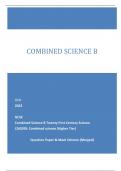
-
OCR 2023 GCSE Combined Science B Twenty First Century Science J260/08: Combined science (Higher Tier) Question Paper & Mark Scheme (Merged
- Exam (elaborations) • 50 pages • 2024
- Available in package deal
-
- $7.99
- + learn more
2 © OCR 2023 0.0 cm A The tester lets go of the ruler. B The participant catches the ruler as soon as they realise the tester has let go of the ruler. C The distance the ruler has dropped is measured. D The participant has their fingers and thumb near, but not touching, the ruler. E The tester holds a ruler above the participant’s hand. 1 Two students are doing an experiment to investigate reaction times. The diagram shows their experiment. Tester Participant (a) The statements...

-
OCR 2023 GCSE Combined Science B Twenty First Century Science J260/01: Biology (Foundation Tier) Question Paper & Mark Scheme (Merged)
- Exam (elaborations) • 59 pages • 2024
- Available in package deal
-
- $7.99
- + learn more
2 © OCR 2023 Chemical Bacteria in the gut compete against pathogens Microbial Skin stops pathogens entering the body Physical Stomach acid destroys pathogens 1 Some bacteria are pathogens that cause diseases. (a) Our blood contains white blood cells. They help protect us against pathogens. (i) Write down the name of the organ that pumps the blood around our body. .............................................................................................................................
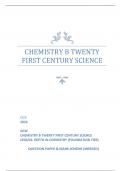
-
OCR 2023 GCSE CHEMISTRY B TWENTY FIRST CENTURY SCIENCE J258/02: DEPTH IN CHEMISTRY (FOUNDATION TIER) QUESTION PAPER & MARK SCHEME (MERGED)
- Exam (elaborations) • 49 pages • 2024
- Available in package deal
-
- $7.99
- + learn more
2 © OCR 2023 1 Poly(ethene) is a polymer which forms when ethene monomers react together in an addition polymerisation reaction. The structure of an ethene monomer and the repeating unit of poly(ethene) are shown in Fig. 1.1. Fig. 1.1 H H H H C C C C H H H H Ethene monomer Repeating unit of poly(ethene) (a) Which statements are true only for an ethene monomer, which are true only for the repeating unit of poly(ethene) and which are true for both? Tick () one box in each row. Tru...

-
OCR 2023 GCSE Combined Science B Twenty First Century Science J260/02: Chemistry (Foundation Tier) Question Paper & Mark Scheme (Merged)
- Exam (elaborations) • 57 pages • 2024
- Available in package deal
-
- $7.99
- + learn more
2 © OCR 2023 1 The diagram shows part of Mendeleev’s Periodic Table. B 11 C 12 N 14 O 16 F 19 Al 27 Si 28 P 31 S 32 Cl 35.5 As 75 Se 79 Br 80 In 115 Sn 119 Sb 122 Te 128 I 127 (a) Give the symbols of the two elements shown in the diagram which are not in order of atomic mass. ........................................................... and ........................................................... [1] (b) Mendeleev left gaps for elements that had not ...

-
OCR 2023 GCSE Biology B Twenty First Century Science J257/01: Breadth in Biology (Foundation Tier) Question Paper & Mark Scheme (Merged
- Exam (elaborations) • 58 pages • 2024
- Available in package deal
-
- $7.99
- + learn more
3 © OCR 2023 Turn over "The larger the animal, the more chromosomes it has in each body cell." 1 (a) Write these structures in order of size. Cell Chromosome Gene Nucleotide Nucleus Smallest ..................................... ..................................... ..................................... ..................................... Largest ..................................... [4] (b) The table shows the number of chromosomes that different animals have in each body cell. ...
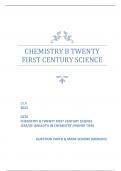
-
OCR 2023 GCSE CHEMISTRY B TWENTY FIRST CENTURY SCIENCE J258/03: BREADTH IN CHEMISTRY (HIGHER TIER) QUESTION PAPER & MARK SCHEME (MERGED
- Exam (elaborations) • 49 pages • 2024
- Available in package deal
-
- $7.99
- + learn more
2 © OCR 2023 1 Argon forms 1% of the air and is unreactive. Argon is used as a replacement for nitrogen when nitrogen is too reactive. (a) Argon is unreactive because it is in Group 0 of the Periodic Table. State one other property of argon. .............................................................................................................................................. [1] (b) Chlorine is very reactive. Argon is unreactive. Explain how the reactivity of these two elements a...
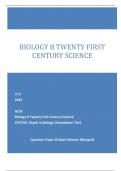
-
OCR 2023 GCSE Biology B Twenty First Century Science J257/02: Depth in Biology (Foundation Tier) Question Paper & Mark Scheme (Merged)
- Exam (elaborations) • 56 pages • 2024
- Available in package deal
-
- $7.99
- + learn more
2 © OCR 2023 ring ring ring 1 Fig. 1.1 shows parts of the human nervous system. Fig. 1.1 Brain Structure B Muscle Spinal cord Structure A (a) Structure A allows us to sense the things we touch. What is the name of structure A? Put a around the correct option. CNS Effector Motor neuron Sensory neuron [1] (b) The muscle contracts to move the arm when it receives a nerve impulse from the brain. What type of structure is the muscle? Put a around the correct option. CNS Effector M...
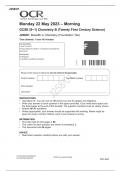
-
OCR GCSE CHEMISTRY B PAPER 1 Foundation tier(Twenty First Century Science)June 2023 Question paper-J258/01
- Exam (elaborations) • 25 pages • 2023
- Available in package deal
-
- $17.99
- + learn more
GCSE (9−1) Chemistry B (Twenty First Century Science) J258/01 Breadth in Chemistry (Foundation Tier) June 2023 Question paper
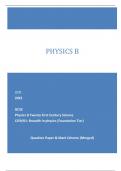
-
OCR 2023 GCSE Physics B Twenty First Century Science J259/01: Breadth in physics (Foundation Tier) Question Paper & Mark Scheme (Merged)
- Exam (elaborations) • 59 pages • 2024
- Available in package deal
-
- $5.49
- + learn more
2 © OCR 2023 Water in a reservoir Pipe Turbine National grid Generator 1 The diagram shows a hydroelectric power station. (a) What is the useful energy store of the water in the reservoir? Tick () one box. Chemical Electrical Gravitational Potential Thermal [1] (b) Many of the main energy resources use a turbine attached to a generator. Complete the table to state what drives the turbine for each energy resource. Tick () one box in each row. What drives the turbine Water Win...

That summary you just bought made someone very happy. Also get paid weekly? Sell your study resources on Stuvia! Discover all about earning on Stuvia


